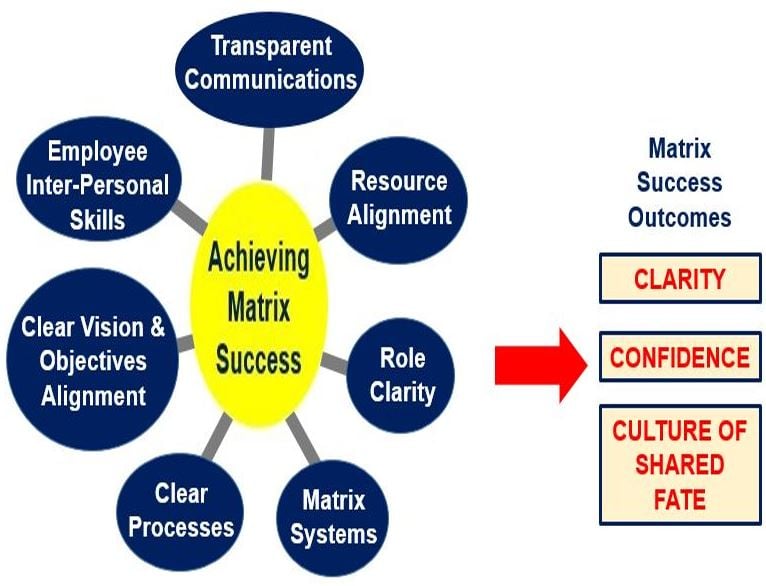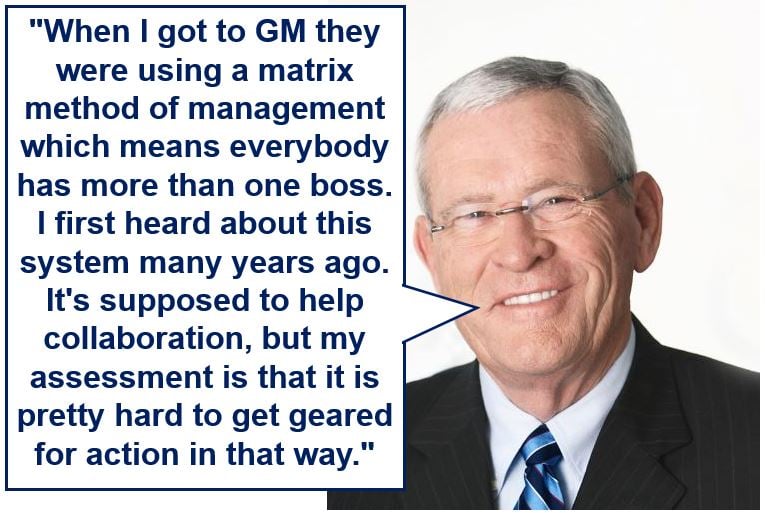A Matrix Organization has a complicated structure in which the reporting relationships are set up as a matrix – a grid – instead of the traditional vertical hierarchy.
Employees in a matrix organization generally report to both a product or project manager as well as a functional manager (department head). The structure facilitates the horizontal flow of information and skills.
Within this framework, employees benefit from a broader perspective on the business, gaining insights from multiple supervisors which can lead to more innovative problem-solving approaches.
In a matrix organization, the traditional departments seen in * functional structures combine with project teams.
* Functional structure refers to basing a department according to functional areas, such as marketing, IT, research & development (R&D), finance, etc.
Matrix management structures are found mainly when there are big projects or product development processes. They draw on employees from a wide range of functional disciplines for assignment to a team – however, they still remain in their respective positions.
Matrix is one of several different organizational structures that employers may adopt.
The dynamic nature of a matrix organization facilitates a fluid and flexible response to market changes, allowing for rapid reallocation of resources and adaptation of management roles.
In a matrix organization you have 2+ bosses
In a matrix organization structure, all the company’s engineers may be working in one engineering department, reporting to the engineering manager. However, some of those engineers might be assigned different projects, and also report to a project manager.
They only do this – also report to the project manager – while they are working on that project. Sometimes, the engineer might have to work under several different managers in order to get his or her job completed.
Philips, a Dutch technology company headquartered in Amsterdam, set up matrix management in the 1970s with its managers reporting to both a product division manager as well as a geographical manager. The grid system soon caught on, and several other large multinationals, including Texas Instruments, Hughes Aircraft, General Motors and Caterpillar Tractor started doing the same – setting up reporting along both project and functional lines.

Organizations may fall somewhere in between the pure matrix and the fully functional. Even basically fundamentally functional organizations sometimes create a special team to handle a crucial project.
In today’s world of business, matrix organizations are considerably more common than they used to be forty years ago. Most large complex organizations exist today at some level of matrix management, especially those with several business units and global operations.
Example of a matrix organization
Imagine you work in an advertising agency as a video producer. You will probably have to report to the media department manager, your functional chain of command boss – the head of your department.
However, you will probably also have to report to somebody who is in charge of a specific project for a client – the project manager – he or she is your boss in the project chain of command.
The functional manager is responsible for all the technical performance of each employee in his or her department, which in this case is video production.
The project manager, on the other hand, is responsible to the overall performance of the product team. He or she is the project’s boss as far as the client is concerned.

Advantages of a matrix organization
Supporters of matrix management argue that in this structure, team members are able to share information more readily across task boundaries, which counters the ‘silo’ limitation of functional management. ‘Silo’ refers to the isolated company department, where all reporting and sharing of information occurs only within that department.
In a matrix structure, reporting and information sharing goes beyond a department’s boundaries, which allows for specialization that can both increase depth of knowledge and assign people according to project needs.
The advantages of having a matrix organization are listed as follows:
- Resources are used more efficiently, where equipment and experts are shared across projects.
- Projects and products are formally coordinated across functional departments.
- Information flows in several different directions within the whole organization, rather than circulating in isolation inside each department (‘silo’ syndrome).
- The company’s employees are in touch with many people inside and outside their department. This helps with sharing information, which in turn speeds up many processes, including decision-making.
- Employees must work autonomously and organize themselves creatively, according to each boss they have to report to. This may boost motivation and decision-making.
- Individuals have the opportunity to use particular skills within a variety of contexts.
- Several departments have less need to meet regularly. This saves money and can improve coordination.
- Projects are usually more cost-effective if human and material resources are shared across departments.
Disadvantages of a matrix organization
- Project team members may have divided loyalties because they have to report to two or more line mangers.
- This kind of scenario – reporting to two or more different bosses – can put team members under considerable pressure.
- Given the complex nature of matrix structures, the line of accountability for project teams may not be very clear.
- It can be hard to coordinate properly. Unless it is well set up and executed, there is a risk of chaos.
- Matrix team members usually need time to get used to functioning effectively in this kind of structure.
- As there is much more to do and remember, matrix team members may neglect their functional duties.
In most cases, the matrix structure does not replace a traditional functional structure – it sits alongside it.
The matrix structure can enhance the professional development of employees by exposing them to diverse managerial styles and cross-functional experiences.
When did the matrix organization emerge?
It is hard to trace the exact origins of the matrix management concept. Some say it started in the 1970s with Philips, as mentioned earlier. According to Britannica.com, the term first appeared in the 1960s in the aerospace industry.
Aerospace companies that wanted government contracts had to develop charts that showed the structure of the project management team that would be in charge of a contract. The chart explained how this team was related to the overall management structure of the company.
Instead of reconfiguring their management systems completely in order to meet the client’s (government’s) requirements, companies decided to create horizontal project units that existed alongside the functional structures – the vertical hierarchies that were already in place.
This approach killed two birds with one stone: 1. It fulfilled the goal of the client – a transparent set of resources led by a group manager. 2. The company did not have to change the fundamental functional structure of the whole organization.
